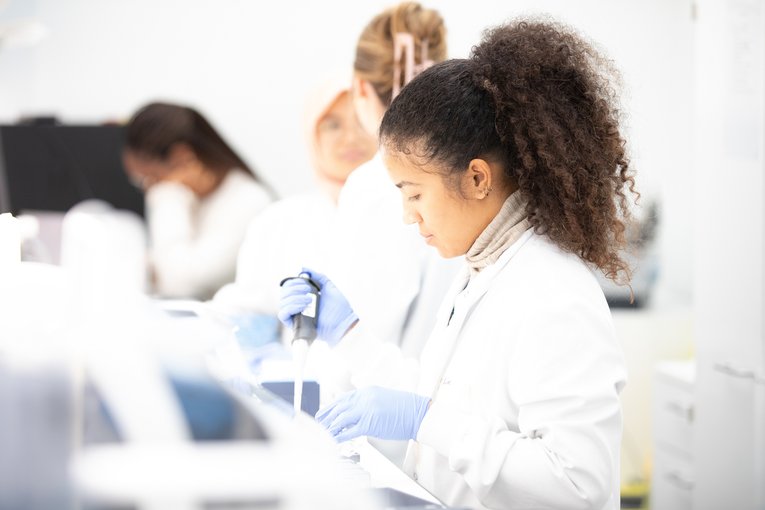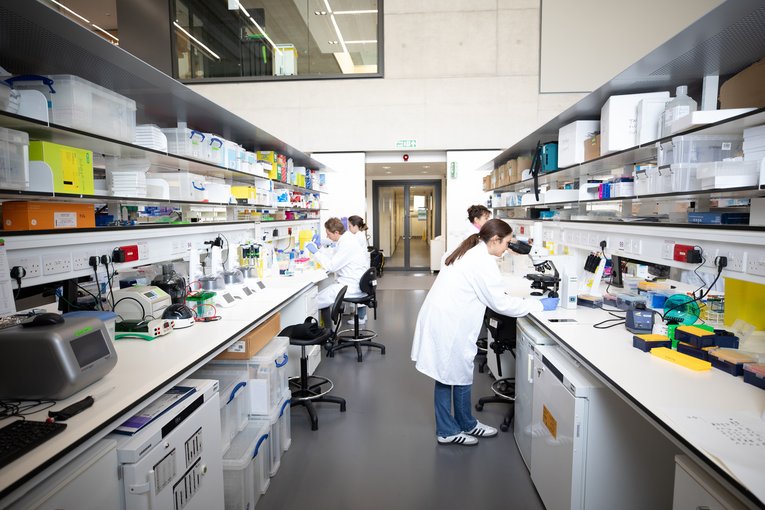
https://www.gosh.nhs.uk/news/first-targeted-gene-therapy-wiskott-aldrich-syndrome-shows-promise/
First targeted gene therapy for Wiskott-Aldrich Syndrome shows promise
12 Aug 2020, 10:02 a.m.
GOSH researchers have shown the power of gene editing technology CRISPR-Cas9 in correcting DNA ‘spelling mistakes’ that cause rare immune system conditions in children.
The world-leading gene therapy team - pictured above in 2019 - showed for the first time that targeting the delivery of genetic material into a patient’s DNA by inserting the sequence at a precise location could lead to better results for patients with Wiskott-Aldrich syndrome (WAS).
Reported today in Nature Communications, these exciting initial results could lead to a new clinical trial for patients with WAS within 3-4 years. Researchers at GOSH and its research partner the UCL Great Ormond Street Institute of Child Health (ICH) are now applying the targeted gene therapy approach to other immune system conditions, including Severe Combined Immunodeficiency (SCID) and X-linked agammaglobulinemia (XLA).
Wiskott-Aldrich syndrome (WAS)
Children born with severe WAS experience debilitating symptoms including easy bruising, bloody diarrhoea and episodes of prolonged bleeding following nose bleeds or minor trauma. They are more vulnerable to infection and at higher risk of developing certain cancers. Without proper treatment, the condition can be life threatening.
WAS is caused by errors written into a section of DNA known as the X-chromosome, of which males have one copy. Women have two copies, providing a ‘back up’ that makes them much less likely to develop symptoms. WAS therefore affects almost exclusively boys, around 3 in every million worldwide.
Treatment
The current standard treatment is a bone marrow transplant, but only around 20% of patients are able to find a suitable matching donor. An alternative approach – gene therapy – has shown promise in recent clinical trials.
‘In standard gene therapy, we deliver a corrected version of the DNA into the patient’s cells and it incorporates into their genetic sequence at a random location,’ says Dr Alessia Cavazza, ICH researcher and lead author. ‘This generally works well, as the cell can still ‘read’ the genetic instruction and create the protein it needs. But because the gene isn’t in exactly the right spot, it can cause issues. These range from minor side effects to significant issues or even treatment failure. In this latest study, we wanted to find a better, more precise way of delivering corrected genes.’
A Promising Result
In results published today, the team showed that CRISPR-Cas9 technology – sometimes called ‘molecular scissors’ – can be used to make a physical cut through DNA at the precise place where the WAS gene is usually found. This guided the gene delivery system to slot the corrected gene into the same part of the sequence that it would be in a healthy person.
This precise placement of the WAS gene corrected around 60% of cells, while leaving them otherwise unaffected and able to continue their normal life cycle of maturing into different types of immune system cells.
‘It’s a really promising result,’ says Dr Rajeev Rai, first author of the paper. ‘We showed that using CRISPR to target the therapy corrects a large percentage of patient cells in living tissue, and that the cells are accepted into the bone marrow and behave as they would in a healthy person. The results suggest this technique could be more effective than the standard approach to gene therapy.’
While some gene editing approaches target specific types of DNA spelling mistakes, making them suitable for only select groups of patients, the team’s CRISPR-guided therapy is designed to correct any form of the genetic disease. This means it could benefit any of the 20-25 WAS patients seen at GOSH every year.
Next Steps
In their new home at the Zayed Centre for Research into Rare Disease in Children, the gene therapy team are now planning the next stage of the study - a thorough, long-term test of safety.
“Cutting through human DNA is no simple thing,” says Dr Cavazza. “We are constantly checking and re-checking our results to look for changes to DNA that we did not intend. Thankfully, we found no issues with such ‘off-target effects’ in this study. That’s really important because it’s essential we do not introduce new problems while trying to fix existing ones. We’ll now do even more testing to make sure it will be safe, before we could proceed to a clinical trial with our patients.”
This safety work will be supported by Great Ormond Street Hospital Children’s Charity (GOSH Charity) and LifeArc, through their partnership funding programme aimed at accelerating laboratory research into benefits for patients. If the outcome of this study is positive, the team expect to seek funding for a clinical trial at GOSH within 3-4 years. This would offer patients the chance to benefit from a promising new treatment.
Work that contributed to this study was funded by the NIHR Great Ormond Street Biomedical Research Centre (BRC), GOSH Charity and Sparks. The next stage of the project – translating the approach towards the clinic – will also be supported by funding from GOSH Charity and LifeArc.

When it is OK to link our data?
A guide for researchers by children and young people containing key principles which reflect children’s and young people’s views about when it is ok to link their data for research.

NIHR launches £13.7m investment into brain tumour research
The National Institute for Health and Care Research (NIHR) has announced a £13.7 million investment that will support ground-breaking research to develop novel brain tumour treatments in the UK.

New consortium aims to help improve care for arthritis patients
A new UK-led research group, including Great Ormond Street Hospital and University College London, aims to improve the lives of children, young people and adults with arthritis by defining for the first time what being in ‘remission’ from arthritis truly

Update for patients and families on industrial action - December 2025
As you may be aware, some of our Resident Doctors will be taking part in planned industrial action from 7am on Wednesday 17 December to 7am on Monday 22 December.
